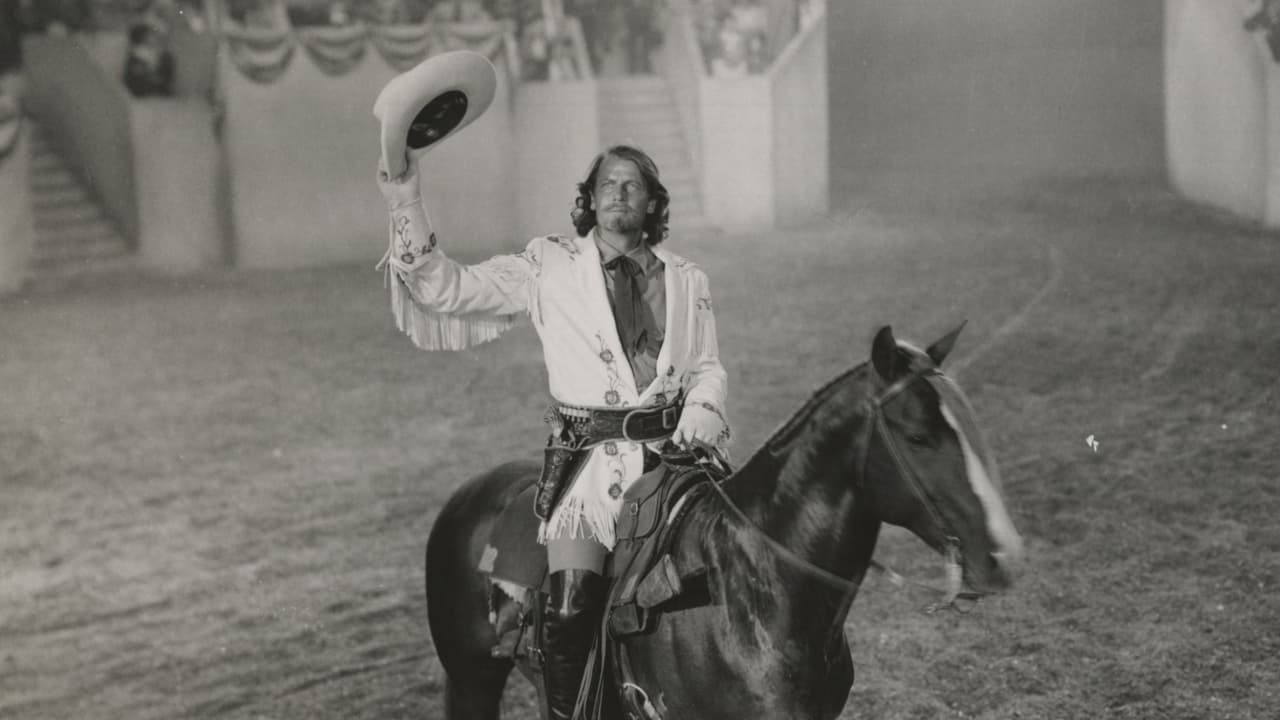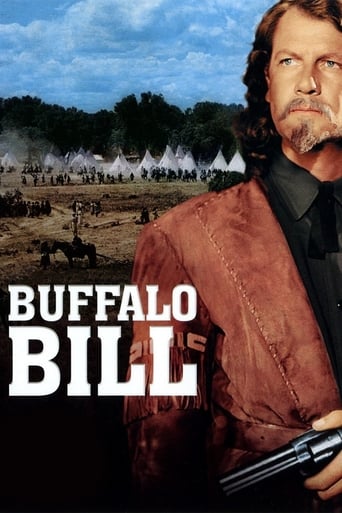

Truly Dreadful Film
... View MoreThat was an excellent one.
... View MoreTerrible acting, screenplay and direction.
... View MoreThis is a tender, generous movie that likes its characters and presents them as real people, full of flaws and strengths.
... View MoreA fascinating recreation of an American legend. Certainly it's not factual. Oddly, one of the few true elements, the hero's descent into side-showing, emerges as a too-familiar cliché, though given a bit of flesh here by McCrea's admirably stoic acceptance and the idea that he's forced into showmanship not by gambling or drink but by sheer financial necessity. In fact Buffalo Bill, the man, is presented as a composite of all the virtues, whilst Buffalo Bill, the picture, is handled with such gusto and panache, so breathtakingly and colorfully photographed, so full of marvelous action with running inserts of stampeding cavalry and Indians on the warpath — all set against superbly eye-catching locations — and so ingratiatingly narrated by Reed Hadley that one can't help but cheer such a grand epic show, produced on such a ding-dong lavish scale. Great technical credits too, including a vivid score and faultless special effects.All this is not to say that "Buffalo Bill" doesn't have its faults. Miss O'Hara is the worst. Looks about as much like a frontier lady as a bird of paradise imitating a sparrow. Even in labor, she's incredibly painted and groomed. In the tiniest of tiny roles, Linda Darnell wipes out Miss O'Hara in their one scene together. McCrea of course is ideally cast. Amongst the support players, we glimpse George Chandler as a sleepy cavalryman and Sidney Blackmer as Teddy Roosevelt. All are effective, with the one proviso that Charles Winninger's old-age make-up is a bit phony and he tends to over-do his usual mannerisms.If I wanted to carp, I could complain about some of the obvious studio back-drops (particularly in the opening scene). Yet despite its occasional faults (and unlike Wellman, I loved the close-out), Buffalo Bill is one exciting movie. What exactly was Wellman's gripe? Here it is: "I didn't like the picture, but I tried to do the best I could with it, but when that poor little crippled kid at the end stands up and says, "God bless you, too, Buffalo Bill", I felt absolutely nauseated."On the other hand, I'm sure Wellman would agree with me that generally the script has its heart in the right place, with pertinent comments to make on wild life preservation and the fate of the Vanishing American. "There are better ways to die," says Yellow Hand when the white man sets about killing off the precious buffalo, "it's a bad thing to starve..." while Cody himself is given the final word on the subject: Dawn Starlight has been killed in battle. Sadly, Cody carries her away. "A friend of yours?" asks the General. "They were ALL friends of mine," Cody quietly replies.
... View MoreBuffalo Bill Cody was portrayed in many movies by many actors, but none has ever captured the look and character as well as Joel McCrea in 20th Century Fox's 1944 Technicolor spectacle Buffalo Bill. Tall, arrow-straight, broad-shouldered, soft-spoken McCrea is simply the embodiment of the famous Indian scout and world renowned showman. Along with the under-rated actor, himself, credit Fox's casting department, tough action director William Wellman, and perhaps most to costumer Rene Hubert. There a many photos of Bill Cody, including a couple from when he was still an unknown Army scout, and Hubert's outfits match them right down to the Indian leggings. But most of all credit whomever -- Wellman, Hubert, or McCrea, himself, decided he had to have a large mustache, goatee and long hair, like the real-life character. This was a harder decision at the time than it may seem to the modern generation. The 1940's was a closely barbered, clean-shaved generation of men. To them, and their women, having a beard or even a mustache bigger than an eyebrow, made a man look like his grandpa. Anathema to a leading man, surely! But there was McCrea with the realistic Cody facial hair. No doubt the decision was heavily influenced by the fact that so many people living in the 1940's had actually seen the real Buffalo Bill, who lived until 1917.This is a lively and well-produced western with a top cast, including McCrea, gorgeous Maureen O'Hara as Mrs. Cody, Linda Darnell as the prettiest Indian squaw who ever existed, Thomas Mitchell as Ned Buntline, Anthony Quinn as Yellowhand, backed up by Edgar Buchanan, Moroni Olsen, and a gang of other solid character actors, such as seemed to grow on trees in that golden era of Old Hollywood. Sumptuous three-strip Technicolor photographed by Leon Shamroy under the sure guidance of Technicolor Corporation's Czarina Natalie Kalmus, exciting battle scenes, rousing David Buttolph score, rich characterization, intelligent if at times heavy-handed script. Cody is idealized, but then so are the Indians, who were in reality not nearly so noble as the present politically correct generation would like to think. Nevertheless, the basics and the spirit of the story are there, and presented in a highly entertaining manner. That's all that counts in a movie.Buffalo Bill is a good show, and that, no doubt, would have been good enough for the real-life Buffalo Bill Cody!
... View MoreI first saw this film in 1944 in Denver, CO., and the last time just recently. It is truly an excellent film. Having lived mostly in Arizona I can certainly understand the plight of the Native American Indian throughout the history of our country.There is a scene in the movie where Buffalo Bill is being honored at a dinner given by a Mr. Vandervere(George Lessey). During the introduction of Buffalo Bill, Mr. Vandervere attributes the quote, "The only good indian is a dead indian" to General William T. Sherman. Sherman may have uttered the quote but it is attributed to General Philip H. Sheridan.Actually, the quote,"The only good indian is a dead indian" is a historical proverb of unknown origin. Edward Ellis in his book, THE HISTORY OF OUR COUNTRY: FROM THE DISCOVERY OF AMERICA TO THE PRESENT TIME(1895) titles a short paragraph, "Sheridan's Bon Mot". Ellis relates an event from an eyewitness account of Captain Charles Nordstrom. It was the writer's good fortune to be present when General Sheridan uttered the Bon Mot in January of 1869 at old Fort Cobb in Indian Territory, now Oklahona, shortly after Custer's fight with Black-Kettle's Band of Cheyennes. Old Toch-a-way(turtle dove), a chief of the Commanches, on being presented to General Sheridan, desired to impress the General in his favor. Striking himself a resounding blow on the breast, he managed to say, "Me, Toch-a-way, me good injun." A quizzical smile lit up the General's face as he set those standing by in a roar by saying, "The only good indians I ever saw were dead." In later years,General Sheridan denied he ever made the comment.
... View MoreWhen this film was made, people were still in love with cars, freeways and bringing progress to the west. So it was quite an achievement to bring to the screen a divided hero, who from one side admired the Indian way of life, and who understood that the killing of the buffaloes would bring misery to the natives, but at the same time arranged buffalo hunts for people of the east, and as a scout helped the army fight the Indians. When he goes east and see stories written about him by Ned Buntline we know that it is impossible for him (as for any human being) to live up to them, and he is bound to end up in ridicule. People nowadays are more ecology conscious and that makes this film more meaningful than in 1944. The first part of the film shows the west and the war with the Indians with excellent battle scenes and great color. Maureen O'Hara is more beautiful than in any other film I've seen her and so is Linda Darnell. The second part is when Buffalo Bill goes east, and that is when the film is at its best.
... View More